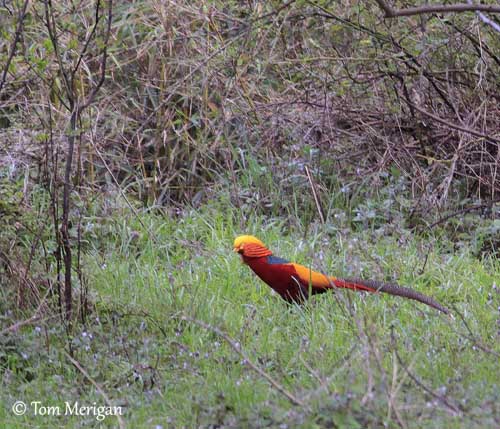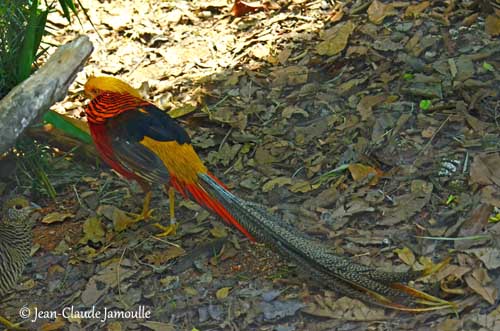
Fr: Faisan doré
All : Goldfasan
Esp : Faisán Dorado
Ital : Fagiano dorato
Nd: Goudfazant
Sd: Guldfasan
Photographers:
Jean-Claude Jamoulle
A la rencontre des Oiseaux
Tom Merigan
Tom Merigan’s Photo Galleries
Text by Nicole Bouglouan
Sources:
HANDBOOK OF THE BIRDS OF THE WORLD Vol 2 by Josep del Hoyo-Andrew Elliot-Jordi Sargatal - Lynx Edicions - ISBN: 8487334156
Hennache, A. & Ottaviani, M. (2005). Monographie des faisans, volume 1. Edition W.P.A. France, Clères, France. ISBN: 2-9512467-1-4
Hennache, A. & Ottaviani, M. (2006). Monographie des faisans, volume 2. Edition W.P.A. France, Clères, France.ISBN: 2-9512467-2-2
Les auteurs renoncent à leurs droits d'auteurs pour que la vente de cet ouvrage, publié par la World Pheasant Association, soit destinée à soutenir des projets de conservation.
BirdLife International (BirdLife International)
Gbwf.org - Dedicated to the Aviculture and Conservation of the World’s Galliformes
ANIMALS – Explore, discover, connect
Golden Pheasant
Chrysolophus pictus
Galliforme Order – Phasianidae Family
INTRODUCTION :
The Golden Pheasant is a brightly coloured bird from central China. Some feral populations are established in UK. This species is common in captivity, but they are often impure specimens, result of hybridization with the Lady Amherst’s Pheasant.
Several mutations of the Golden Pheasant are seen in captivity, with different plumage pattern and colours. The wild type is known as “Red Golden”.
The wild Golden Pheasant is living in the mountains of Central China, and often occurs in dense forests. This shy bird usually hides in dense forested areas. This behaviour could be a kind of natural protection of their bright-coloured plumage. Actually, these bright colours could be susceptible to become paler if exposed to sun for long hours during the day.
The Golden Pheasant is a very popular species.

DESCRIPTION OF THIS BIRD:
Biometrics:
Length male: 100-115 cm including the tail: 63-79 cm
Length female: 61-70 cm including the tail: 34-38 cm
Wingspan: 65-75 cm
Weight: 550-700 gr
The Golden Pheasant male has silky golden yellow crest with faint red tips. Face, chin, throat and neck sides are rusty. The bare skin of wattles and eye-ring is yellow. The ruff, sometimes called “cape”, is pale orange with bluish-black feather’s edges, involving regular scaling.
The bill is yellow. The eyes are pale yellowish to whitish. Legs and feet are dull yellow. We can see a spur behind the leg.
On the upperparts, the upper back is deep green, whereas the lower back and the rump are golden yellow. Scapulars are dark red. Tertials are dark blue, while primaries and secondaries are brown barred creamy-white. Upperwing coverts are rusty. The long tail feathers are black, heavily spotted pale cinnamon, and tipped cinnamon-buff. We can see several rectrices with red bases, except the central ones. At rest, they are similar to flames.
On the underparts, the breast is scarlet, whereas flanks, belly and vent are scarlet and pale chestnut.
The female (or hen) is much duller with dark brown eyes. She has rufous brown plumage overall with dark barring, making her almost invisible when she incubates on the ground. Face and throat are buff. Breast and body sides are barred buff and dark brown. The belly can be plain buff, but it may vary according to each bird.
The immature resembles female but it has spotted tail and several red patches on its plumage.
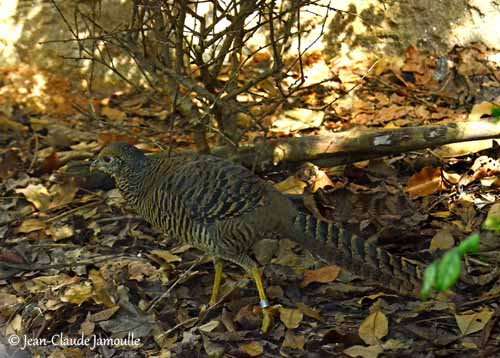
RANGE:
The Golden Pheasant is found in the mountains of Central China. The species has been locally introduced to England, Scotland and Wales.
HABITAT:
The Golden Pheasant is found in mountains and valleys where it frequents dense forests and woodlands with thick undergrowth of shrubs and bamboos.
Introduced pheasants occur in the same type of habitat in other countries.
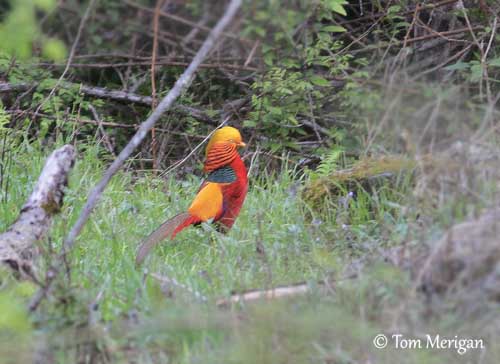
CALLS ANS SONGS: SOUNDS BY XENO-CANTO
The Golden Pheasant gives “chack chack” sounds, and during the breeding season, the male utters metallic calls.
Pheasants have a wide range of calls such as advertising calls, contact calls, alarm calls used in great variety of situations.
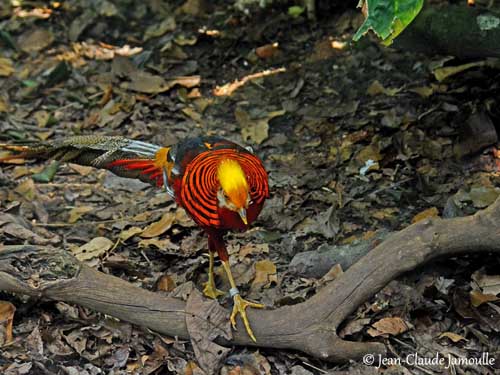
BEHAVIOUR IN THE WILD:
The Golden Pheasant feeds primarily on plant materials such as berries, seeds, leaves and tender shoots of shrubs and bamboos, and rhododendron flowers. But it may take spiders and various insects too.
During the day, it forages on the ground by walking slowly and pecking. It usually feeds in the early morning and the late afternoon, but it may move all day round.
At night, it reaches a nightime roost in very high trees.
During the breeding season, the male displays and enhances its superb plumage by posturing and strutting, and performing various movements in front of the female. During these displays, it spreads his neck feathers (ruff) over head and bill, like a cape.
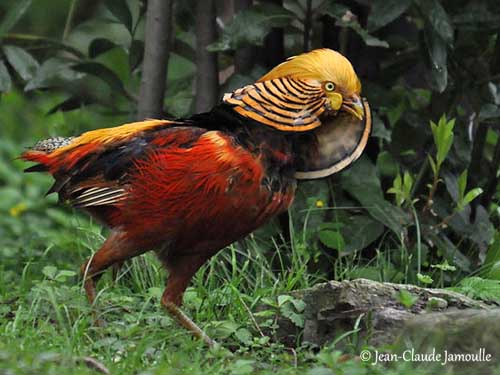
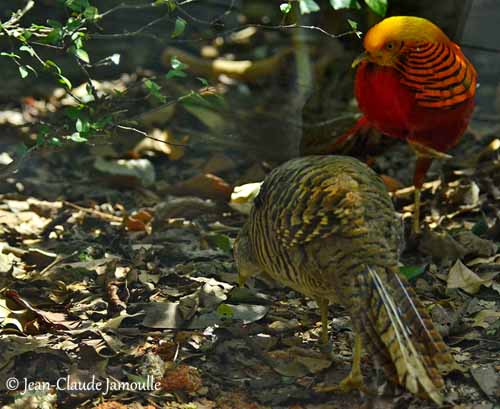
The Golden Pheasant is mainly terrestrial and prefers to run instead to fly. But it can abruptly and rapidly burst upwards if it is startled. At this moment, we can hear a distinctive wing sound.
Pheasants are able to fly in short bursts, but they are clumsy in flight due to their short wings and long tail.
This species probably performs limited seasonal movements for food.
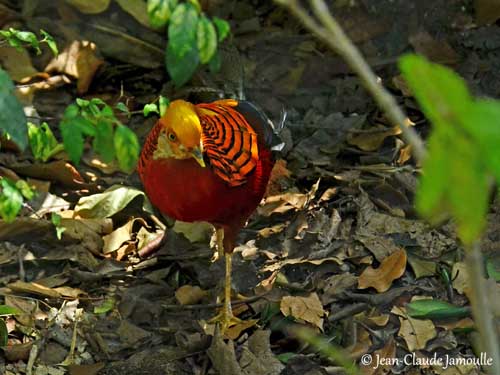
REPRODUCTION OF THIS SPECIES:
The laying occurs in April.
The Golden Pheasant builds its nest on the ground in dense brush and bushes, or in tall grass. This is a shallow depression lined with plant materials.
The female lays 5-12 eggs and incubates during 22-23 days.
At hatching, the chicks are covered in rufous-brown down above with pale buff bars, and buffy-white below. They are precocial and can move and feed very soon. They usually follow the adult to the food sources and then, peck at food on their own.
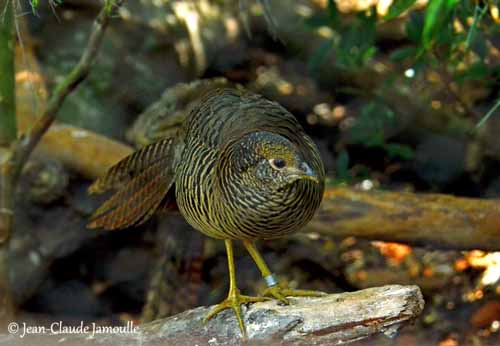
PROTECTION / THREATS / STATUS:
The Golden Pheasant is not currently threatened, but deforestation, live bird trade and hunting for food consumption involve several declines although populations appear currently stable.
This species often hybridizes in captivity with the Lady Amherst’s Pheasant. In addition, several mutations have been developed over the years, involving rare pure species.
